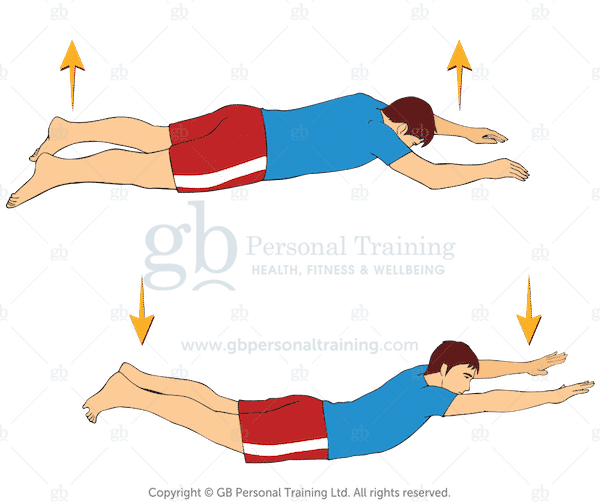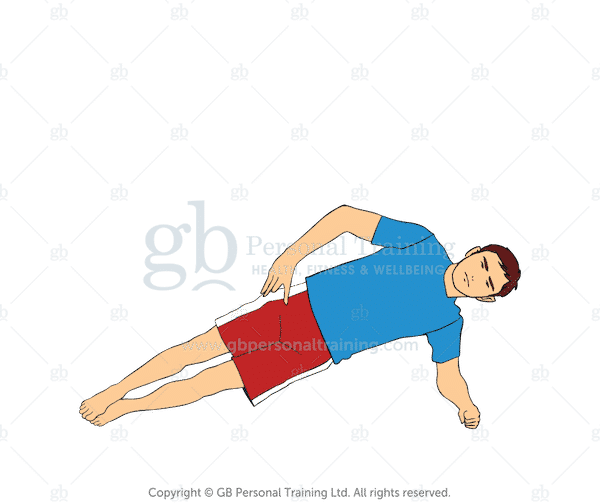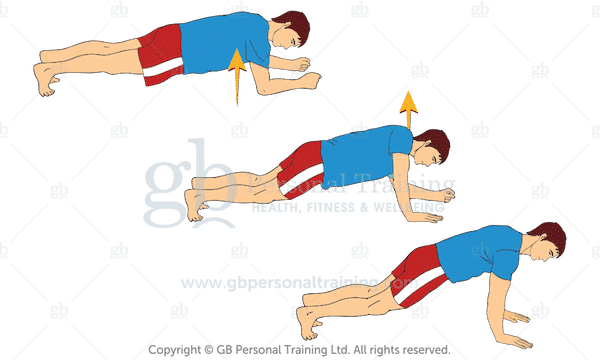
What is functional training?
Functional Training has been used as a buzz word for many years now.
The idea behind functional training is that each exercise should be more natural and carry over into daily life.
For example: improving your squats would help you get up and down from a chair and lunges would make climbing stairs easier.
Functional exercises tend to activate more muscles and therefore consume more energy.
These multidimensional exercises also tend to improve your natural movement skills and enhance your general mobility.
See how many of the below functional training exercises you can incorporate into your workouts for a more practical and fat burning workout.
Here are a list of functional exercises:
# 1 – Dumbbell Reverse Lunge with Rotation
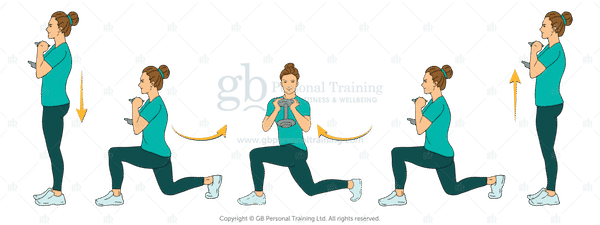
The Reverse lunge with Rotation combines a lot of movement changes and challenges your balance, mobility and core stability all at the same time.
It is important to ensure that the rotation comes from the midsection of the body rather than the shoulders.
The back knee should not rest on the floor during the rotational part of the movement.
Ensure that this functional movement exercise is divided into 3 parts:
- The Reverse Lunge
- Then the Rotation back and forth
- Finally the step back to the stating position
Functional Training Workout Example: 10 repetitions each side, rest 60 seconds and repeat for a total of 3-5 sets.
Want more? See 16 Kettlebell Lunge Variations
# 2 – Hip and Thoracic Openers

This hip opening exercise can be used as part of your warm up or as part of your main functional training program.
Due to most peoples sedentary lifestyles the hips can become very stiff with limited mobility. Tight hips will cause lower back issues and general movement compensations.
This functional movement exercise not only opens the hips but also strengthens the core muscles and improves mobility in the upper spine too, another common area that lacks mobility due to too much sitting.
Breathing is a key part to this exercise so ensure that you breathe out as you sink your hips down into the movement.
Workout Example: Try 20 alternating repetitions with controlled breathing
# 3 – Single Leg Dumbbell Row

Rowing exercises are very important because not only do they counteract all the sitting that we do but they also target a huge amount of neglected muscle mass on the back.
As soon as you start standing on one leg and performing a row lots of great things start to happen.
Standing on one leg improves hip stability which is essential because most people have weak external rotation which affects gait.
The one legged stance also encourages greater core activation in order to deal with rotational forces placed on the body during the one arm row.
A flat back is vital throughout this functional training exercise to keep the spine protected.
Try to work on the mid back muscles by rowing towards the hips rather than shrugging the shoulders.
Workout Example: Try 8 repetitions each side, rest 60 seconds and repeat for 3-4 sets.
Want more? 6 Kettlebell Row Variations for a Strong Back
# 4 – Break Dancer Push Up

The break dancer push up takes the regular push up and adds another dimension.
Performing this exercise will improve your shoulder stability as well as increasing your mobility through your hips.
Once you get the hang of this functional movement exercise you can increase the speed and get cardiovascular benefits from it too.
As with all Push up variations they require excellent core strength in order to complete the movement correctly.
Workout Example: Start the clock and see how many great repetitions you can perform in 60 seconds!
# 5 – Yoga Squat

Possibly one of my favourite squatting movements and superb for developing leg strength and all over mobility.
During the yoga squat concentrate on your breathing.
This functional training exercise is broken down into 4 parts:
- Squat down into a deep squat (Breathe Out)
- Hands down and straighten the legs (Breathe In)
- Return to a deep squat and hands up (Breathe Out)
- Stand back up tall (Breathe In)
Only move as fast as your breathing will allow and work on trying to straighten the legs while the fingertips are touching the floor.
Functional Training Workout: Complete as many repetitions as possible with good breathing
Learn more: 7 Kettlebell Squats You Need to Know
# 6 – Kettlebell Turkish Get Up
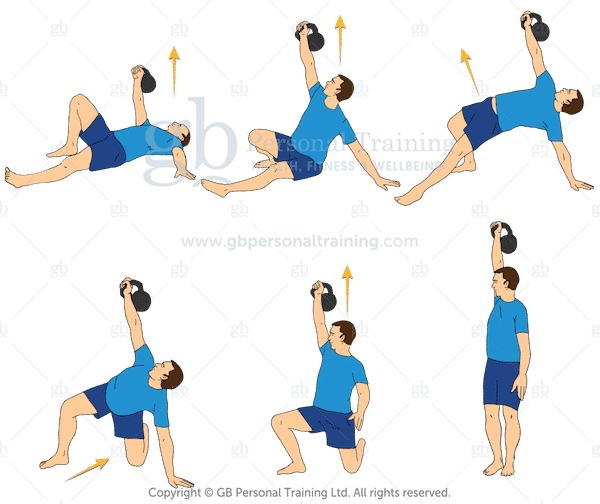
The ultimate full body functional exercise that not only improves your overall strength but your overall mobility too.
The Get Up exercise is excellent when performed with a kettlebell but it can be equally effective with a dumbbell or just with your own body weight.
In fact, for the fitness newbie there is no better functional training exercise to begin with.
I would argue that you should never start pressing a weight above your head until you can perform a Turkish Get Up with the same weight.
The benefits that can achieved from this exercise cannot be stressed enough.
Want more? Ultimate Guide to the Kettlebell Turkish Get Up
Functional Training Workout: 1 Left Side, 1 Right Side, 2 Left Side, 2 Right Side, continue for as high as you can go.
# 7 – Side Lunge with Reach

Not enough people perform the side lunge and by adding a reach it creates yet another dimension.
Side lunges work into the buttocks as you overload the one side.
They also encourage strengthening of the back extensors as you struggle against gravity to keep your chest up.
Finally, they are excellent at increasing hip mobility as the legs are separated during the lunge.
Ensure during the lunge that the chest is kept high and the weight is kept back on the heels rather than the toes.
As you get the hang of this functional training exercise and you start to warm up try to get deeper and deeper towards the floor for added hip mobility.
Functional Training Workout: 5 Left, 5 Right, 10 Left, 10 Right, 5 Left, 5 Right.
# 8 – Overhead Warm Up with Dumbbells

Now for a great warm up exercise that can be used before you start your main workout or as part of your workout session.
This functional exercise works the shoulder stabilisers but also your core stabilisers as you move dynamically from the kneeling to the standing position.
The core muscles act in many different ways depending upon your foot position, so your core may be strong during the squat but weak during the lunge.
Just because you have ripped abs doesn’t mean you can stabilise your spine correctly during movement.
Take your time with the exercise and feel how your shoulders and core work hard to stabilise the dumbbells above your head.
Functional Training Workout: Try 10 Leading with the Right leg and the 10 leading with the Left leg.
# 9 – Stir the Pot with a Stability Ball
If you are ready for a serious core exercise then this is the one for you.
This functional exercise works also every muscle of your core along with your shoulders, back, chest, buttocks and legs.
You begin in a standard plank position on the stability ball but then rotate the arms around in a circle going as far forwards as you can manage.
The further forward you push your elbows away from you the harder the exercise becomes.
I would recommend that everyone master the regular plank first before moving onto this more advanced exercise. Keep the core muscles tight at all times and never let the hips sag below horizontal.
Functional Training Workout: 3 Rotations Clockwise, 3 Rotations Anti-Clockwise
# 10 – Dumbbell Reverse Lunge and Press

During this super calorie burning functional exercise we combine two huge movement patterns the lunge and the overhead press.
As you perform the reverse lunge you use the forward momentum coming out of the movement to help you drive the dumbbells above your head.
Try and combine the two movements rather than just lunging first and pressing second.
Alternating legs after each press will ensure that you use as many muscles as possible throughout your workout.
Functional Workout Example: Try 20 alternating repetitions, rest 60 seconds and repeat 3-4 times for a serious fat burner!
# 11 – Kettlebell Snatch

This kettlebell exercise is great at connecting the lower half of the body with the top half.
You will work practically every muscle in your body during this explosive functional training exercise.
The Kettlebell snatch can be hard to master and certainly should not be attempted by the beginner.
Good stable shoulders, practical core strength and even good grip strength is required to ensure that you make it through this exercise in one piece.
However, once perfected the Snatch is one of the best explosive exercises around.
Want more? Ultimate Guide to the Kettlebell Snatch
Functional Workout: Try the Snatch challenge, as many Snatches as possible in 10 minutes without putting the kettlebell down.
# 12 – Double Lunge and Reach

The double lunge takes your lunging exercise to another dimension.
Performing the double lunge overloads the buttocks, hip and thighs as well as putting your heart rate through the roof.
Including a reach into the movement just makes this functional exercise very tiring indeed.
The double lunge requires you to combine both the forward lunge with the reverse lunge.
The foot should not touch the floor between lunges so the movement happens reasonably quickly.
Practice both the forward lunge and the reverse lunge before attempting to put them together.
Workout Example: 5 Double Lunges Left, 5 Right, Rest for 1 minute and repeat 3-4 times.
Want more? 51 Bodyweight Exercises You Can Do Anywhere
# 13 – Stability Ball Push Ups
The stability ball push up takes away the stable floor and adds a real challenge to the chest, shoulders and core muscles.
The wrists and forearms will also get a good workout from this push up variation.
If you are new to this type of functional exercise then you may want to have someone hold the stability ball in place before you start doing the exercise alone.
Keep the core rigid and tight throughout the exercise and experiment with wrist position until you find one that suits you best.
Workout Example: 10 reps, rest 60 seconds and repeat for 3-4 sets.
Conclusion to Functional Training Exercises
So that completes my list of 13 Functional Training Exercises.
You will notice from the list that we have an exercise for every important movement pattern:
- Squat
- Lunge
- Deadlift
- Push
- Pull
The 13 functional training exercises also incorporate the 3 fundamental movement planes:
- Frontal (side to side)
- Sagittal (forwards and backwards e.g.. running)
- Rotational (twisting around the centre line)
Why not try incorporating 1 or 2 of the above exercises into your standard workout program.
I think you’ll be amazed at the difference they will make.
Love these functional training exercises?
Then you’ll love my Kettlebell Workouts website



